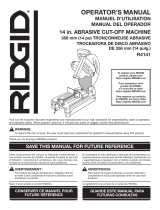Français
17
9. PORTER DES VÊTEMENTS APPROPRIÉS PENDANT LE TRAVAIL. Ne jamais porter de
vêtements lâches ni de gants, cravate, bagues, bracelets ni aucun autre bijou qui pourraient se coincer
dans les pièces en rotation. Toujours porter des chaussures anti-dérapantes, de préférence avec des
doigts de pied en acier. Porter un couvre-chef qui recouvre les cheveux longs.
10. TOUJOURS PORTER DES LUNETTES DE PROTECTION PENDANT LE TRAVAIL POUR
ÉVITER TOUT RISQUE DE BLESSURE DES YEUX. Les lunettes ordinaires N’assurent PAS une
protection suffisante parce que les verres ne sont pas faits en verre résistant aux chocs. Par ailleurs,
porter un masque sur le visage pour accroître la sécurité, et un masque anti-poussière si le travail doit
dégager de la poussière.
11. TOUJOURS FIXER LA PIÈCE DANS L’ÉTAU OU SUR LE SOCLE. Utiliser des dispositifs de
serrage ou un étau pour tenir la pièce. Cela sera plus sûr que de tenir la pièce à la main et libérera les deux
mains pour le travail.
12. NE JAMAIS TROP SE PENCHER. Toujours garder une bonne assise et un bon équilibre pendant
le travail.
13. TOUJOURS ENTRETENIR LES OUTILS AVEC SOIN. Toujours maintenir les outils aiguisés et
propres pour optimiser le travail et la sécurité. Toujours suivre les instructions de graissage et de
remplacement des accessoires.
14. TOUJOURS DÉBRANCHER L’OUTIL avant un entretien et lors du remplacement du disque à
tronçonner ou de tout autre accessoire.
15. NE JAMAIS RISQUER UNE MISE EN MARCHE INOPINÉE LORSQU’ON BRANCHE
L’OUTIL. Toujours vérifier que l’interrupteur est en position “OFF” avant de brancher la fiche
d’alimentation dans la prise secteur.
16. TOUJOURS UTILISER EXCLUSIVEMENT LES ACCESSOIRES RECOMMANDÉS POUR
L’OUTIL. Consulter le manuel d’instructions pour la description des outils recommandés. Pour éviter
tout risque de blessure, utiliser exclusivement les accessoires recommandés pour cet outil.
17. NE JAMAIS SE TENIR DEBOUT SUR L’OUTIL. Pour éviter tout risque de blessure grave, ne pas
toucher l’outil et éviter tout contact fortuit avec le disque à tronçonner.
18. TOUJOURS VÉRIFIER SI L’OUTIL A DES PIÈCES ENDOMMAGÉES AVANT DE L’UTILISER.
Toujours vérifier si la protection et les autres composants sont endommagés avant d’utiliser l’outil pour
s’assurer qu’ils fonctionneront correctement. Vérifier si toutes les pièces mobiles sont bien alignées, non
voilées, ou toute autre condition qui pourrait entraver leur bon fonctionnement. Toujours réparer ou
remplacer les protections ou les autres pièces endommagées avant d’utiliser l’outil.
19. NE JAMAIS S’ÉLOIGNER DE L’OUTIL QUAND IL FONCTIONNE ; TOUJOURS LE
METTRE HORS TENSION QUAND ON NE S’EN SERT PAS. Toujours débrancher le cordon
d’alimentation quand on ne se sert pas de l’outil. Ne pas s’éloigner de l’outil tant qu’il n’est pas
complètement arrêté.
20. L’outil n’est pas conçu pour des applications de fabrication en série, et il ne devra donc pas être utilisé
dans un environnement de fabrication en série.
21. L’outil est conçu exclusivement pour un usage domestique.
22. Pour les réparations, utiliser exclusivement des pièces de rechange agréées.
23. Alimenter l’outil exclusivement sur un courant alternatif de 115 volts. Une tension ou une alimentation
incorrectes pourraient provoquer un mauvais fonctionnement de l’OUTIL ELECTRIQUE et provoquer de
graves blessures physiques ou de graves dommages matériels de l’outil.
Consignes de sécurité spéciales pour cet outil électrique
AVERTISSEMENT: Pour éviter tout risque de blessure, respecter les consignes de sécurité spéciales
suivantes lors de l’utilisation de l’OUTIL ELECTRIQUE :
CHOSES À FAIRE
TOUJOURS OBSERVER LES CONSIGNES SUIVANTES POUR GARANTIR UNE UTILISATION
EN TOUTE SÉCURITÉ :
1. Bien lire le manuel et se familiariser avec les consignes de sécurité et les instructions d’utilisation de
l’OUTIL ELECTRIQUE avant de l’utiliser.
2. Toujours vérifier que l’OUTIL ELECTRIQUE est propre avant de l’utiliser.




















